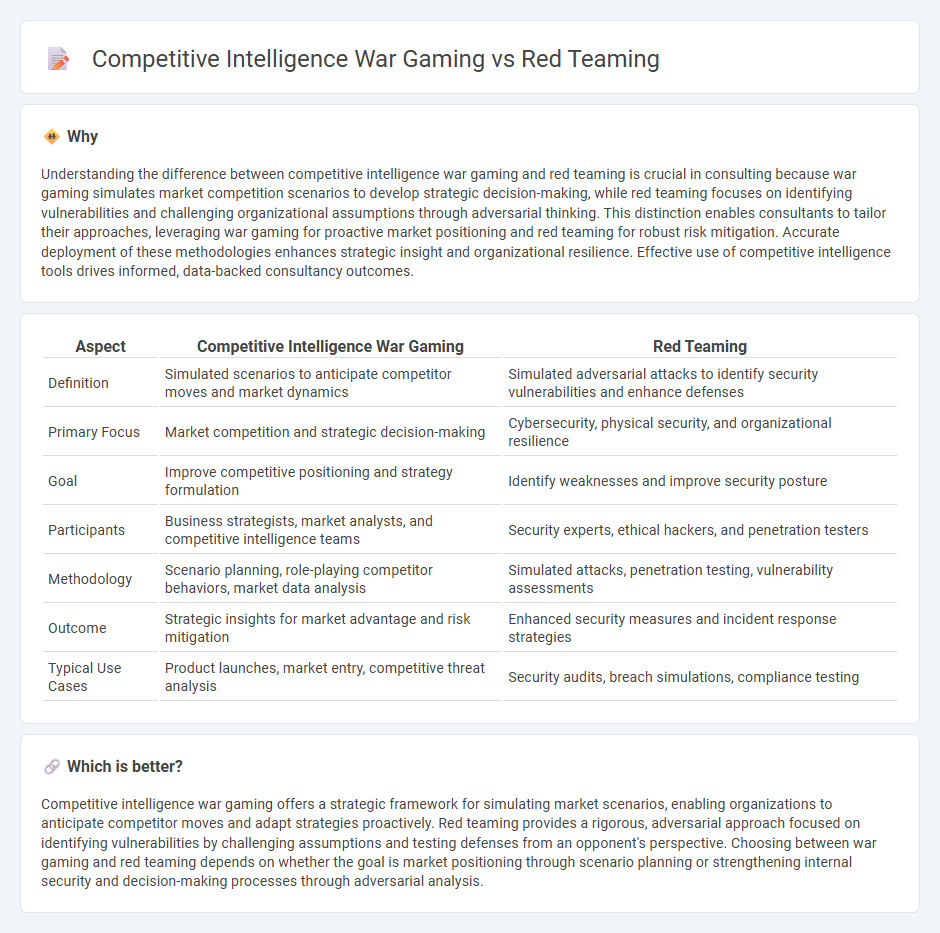
Competitive intelligence war gaming simulates market dynamics and competitor strategies to anticipate business moves, while red teaming focuses on identifying vulnerabilities from an adversary's perspective to strengthen defenses. Both methods provide critical insights for strategic decision-making by uncovering hidden risks and opportunities in complex competitive landscapes. Discover how integrating these approaches can elevate your consulting outcomes and sharpen your strategic edge.
Why it is important
Understanding the difference between competitive intelligence war gaming and red teaming is crucial in consulting because war gaming simulates market competition scenarios to develop strategic decision-making, while red teaming focuses on identifying vulnerabilities and challenging organizational assumptions through adversarial thinking. This distinction enables consultants to tailor their approaches, leveraging war gaming for proactive market positioning and red teaming for robust risk mitigation. Accurate deployment of these methodologies enhances strategic insight and organizational resilience. Effective use of competitive intelligence tools drives informed, data-backed consultancy outcomes.
Comparison Table
| Aspect | Competitive Intelligence War Gaming | Red Teaming |
|---|---|---|
| Definition | Simulated scenarios to anticipate competitor moves and market dynamics | Simulated adversarial attacks to identify security vulnerabilities and enhance defenses |
| Primary Focus | Market competition and strategic decision-making | Cybersecurity, physical security, and organizational resilience |
| Goal | Improve competitive positioning and strategy formulation | Identify weaknesses and improve security posture |
| Participants | Business strategists, market analysts, and competitive intelligence teams | Security experts, ethical hackers, and penetration testers |
| Methodology | Scenario planning, role-playing competitor behaviors, market data analysis | Simulated attacks, penetration testing, vulnerability assessments |
| Outcome | Strategic insights for market advantage and risk mitigation | Enhanced security measures and incident response strategies |
| Typical Use Cases | Product launches, market entry, competitive threat analysis | Security audits, breach simulations, compliance testing |
Which is better?
Competitive intelligence war gaming offers a strategic framework for simulating market scenarios, enabling organizations to anticipate competitor moves and adapt strategies proactively. Red teaming provides a rigorous, adversarial approach focused on identifying vulnerabilities by challenging assumptions and testing defenses from an opponent's perspective. Choosing between war gaming and red teaming depends on whether the goal is market positioning through scenario planning or strengthening internal security and decision-making processes through adversarial analysis.
Connection
Competitive intelligence war gaming and red teaming intersect as strategic approaches that simulate real-world scenarios to uncover vulnerabilities and anticipate competitor moves. Both methodologies leverage adversarial analysis to enhance decision-making and risk mitigation in consulting projects. Integrating these practices enables consultants to develop robust strategies by systematically challenging assumptions and exploring competitive dynamics.
Key Terms
Threat Simulation
Red teaming emphasizes realistic threat simulation by mimicking adversaries to identify vulnerabilities in cybersecurity systems and organizational defenses. Competitive intelligence war gaming focuses on strategic decision-making by simulating competitor moves and market scenarios to anticipate risks and opportunities. Explore detailed methodologies and best practices to enhance your threat simulation capabilities.
Market Analysis
Red teaming in market analysis involves simulating adversarial actions to identify vulnerabilities in business strategies, whereas competitive intelligence war gaming focuses on anticipating competitor moves through scenario-based simulations to inform strategic decision-making. Both methods leverage data-driven insights but differ in approach: red teaming challenges internal assumptions, while war gaming models competitive dynamics. Explore our comprehensive guide to deepen your understanding of these critical market analysis techniques.
Scenario Planning
Red teaming involves simulating adversary tactics to identify vulnerabilities and test defensive strategies, enhancing organizational preparedness. Competitive intelligence war gaming focuses on forecasting competitor behavior through scenario planning to inform strategic decisions and mitigate risks. Explore detailed methodologies and benefits to optimize your strategic planning processes.
Source and External Links
What is red teaming? | Definition from TechTarget - Red teaming is the practice of rigorously challenging plans, policies, systems, and assumptions using an adversarial approach, often involving simulation of attacks to test and improve security defenses in organizations.
What Is a Red Team? - Picus Security - Red Teaming involves simulating real-world cyberattacks by security professionals to identify vulnerabilities, test incident response, and improve organizational security posture by mimicking sophisticated adversaries' tactics.
What is Red Teaming? | IBM - Red teaming is an ethical hacking method where experts conduct simulated cyberattacks to proactively find security weaknesses and help organizations strengthen defenses against fast-moving cyber threats.
 dowidth.com
dowidth.com